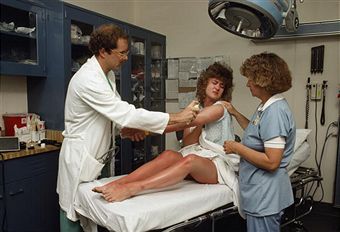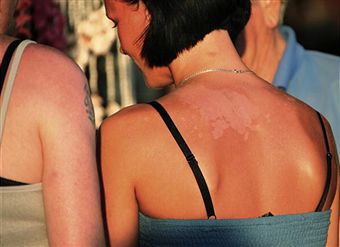Each year thousands of people suffer from heat related illnesses. Some of these illnesses can be treated by taking time to rest and drink fluids, but heat stroke, the most serious of these conditions, may require intense medical treatment. Heat stroke should not be confused with other heat disorders that are less severe. To understand heat stroke, it is necessary to define related heat disorders.
Conditions that may be confused with heat stroke
Heat stroke is not to be confused with heat cramps which are the result of strenuous activity during hot weather. Excessive sweating leading to loss of salt and fluid causes heat cramps. Heat cramps are felt as muscle pain or spasms in the abdomen, legs or arms. Usually resting and drinking fluids such as sports drinks will help an individual recover from heat cramps.

Heat exhaustion is usually a condition that is seen in older adults, especially those with high blood pressure. However, people who work in settings where the temperature is hot and those who do strenuous exercise in hot weather can also suffer from heat exhaustion. Heavy sweating, muscle cramps, weakness and dizziness are all symptoms of heat exhaustion. Some people also experience nausea and vomiting. Heat exhaustion that is not treated can lead to heat stroke.
Heat Stroke
Heat stroke is sometimes called sun stroke or hypothermia. “Hypo” means high or excessive and “thermia” means heat, thus hypothermia means excessive heat. Heat stroke is the most severe of the heat related illnesses. When a person suffers a heat stroke, the core body temperature rises to dangerous levels. When the body temperature rises higher than 40 degrees Celsius or 104 degrees Fahrenheit a person is diagnosed as having a heat stroke. When an individual suffers heat stroke, the body is not able to give off heat fast enough, which causes the temperature to increase.
Usually heat leaves the body through perspiration or sweat, which evaporates. When temperatures are extreme or humidity is high and the body does not have enough fluid for sweating to occur, it can become overheated. Adults lose about ten cups of water per day through sweating, breathing, and urination. Diarrhea and vomiting also cause fluid loss. In extreme heat conditions profuse sweating can cause additional fluid loss. Certain medications, especially those with diuretic effects can lead to dehydration. All of these modes of fluid loss can impair the body’s ability to dissipate heat by sweating.
Being exposed to high heat environments while working; doing yard work on very hot days, living in a house without air conditioning, or being inside of a hot car can all cause heat stroke. The body’s response to heat becomes more severe as people grow older. In extreme conditions, a seventeen year old might suffer heat cramps, but in the same situation, a sixty year old may suffer a heat stroke due to age.
Heat Stroke? Get Remedies Fast!
Types of heat stroke
There are two categories of heat stroke. Heat strokes may be caused by exertion. This type of heat stroke is generally experienced by younger persons who exercise, work or play sports for long periods of time under extreme heat conditions. This type of heat stroke is known as exertional heat stroke or (EHS).
The other type of heat stroke is non-exertional or (NEHS). Young children, older adults and those with chronic illness usually suffer this class of heat stroke. Non-exertional heat strokes occur in extremely hot weather or heat waves which may be unusual for an area. Both types of heat stroke can be deadly if not treated immediately.
People who are at high risk for heat stroke
Anyone can be at risk for heat stroke. Older adults, young children, people on certain types of medications, sick persons, those who work outside during the summer and people who engage in strenuous exercise in hot weather are all at risk. Obese persons and those who are not physically fit and those who suffer from chronic illness are among those who are at high risk for non exertional heat stroke.
Symptoms of heat stroke
Knowing the symptoms of heat stroke can help individuals prevent the condition or save someone’s life. The symptoms of heat stroke include increased body temperature, red, flushed skin, rapid heart beat, difficulty breathing, confusion, odd behavior, disorientation, seizures, coma and in children, fussiness and sleepiness in children.
Cures and remedies for heat stroke
Heat stroke is a medical emergency. If heat stroke is suspected, 911 should be contacted immediately. Failing to get immediate help for heat stroke can lead to serious health problems including permanent organ damage and death. Rapid cooling of the victim’s body should begin right away. While waiting for medical help to arrive, heat stroke victims should be put in a cool place or in a shady area. The victim should be cooled down by removing the clothes and using a cloth or sponge to apply cool water liberally to the skin.
If a garden hose is available cool water can be sprayed on the individual’s body to cool them down. Other options include wrapping the victim in cool wet sheets or placing them in a bathtub of cool water. Ice packs under the armpits or in the groin are also recommended to speed cooling. Medications such as aspirin and acetaminophen should not be used.
While these are used to treat fevers, they are not effective in cooling down a person who has suffered a heat stroke. Temperature should be monitored using a thermometer. Emergency medical personnel can provide guidance to help keep the person with heat stroke safe until they can arrive.
Once an individual arrives at the hospital other measures can be used to reduce body temperature to a safe level, including giving intravenous fluids and hemodialysis. A fan is sometimes used to help cool the body.
Prognosis
Heat stroke can be treated successfully with many people enjoying full recovery. The risk of death from heat stroke depends on several factors including age–how old or young the victim is; whether the victims has conditions such as heart and lung problems, and whether there are issues with the kidneys or liver.
The body temperature level and how long the body temperature remains high can impact whether a person will recover fully. It should be noted that in about 20% of people who suffer heat strokes, there can be permanent damage. Brain function can be impaired leaving a person with poor coordination, inability to perform some tasks, and personality changes. The kidneys can also suffer permanent damage.
Preventing heat stroke
Hundreds of deaths occur each year due to heat stroke, but these deaths can be prevented. During heat waves or extreme hot weather, family members and friends should make a point of checking on elderly neighbors to make sure they have a cool environment as well as food and drinks to provide adequate hydration.
Get adequate amounts of fluid
Staying hydrated is a key factor in preventing heat stroke. Drinking plenty of water or sports drinks during strenuous activity can help keep the body cool in very hot environments. The best choices are caffeine free, alcohol free and low-sugar drinks since those with caffeine and sugar can cause fluid loss.
Lack of thirst is not an indicator of whether an individual needs to drink fluids. Adequate fluids should be consumed even when a person is not thirsty. Three to four cups of water per hour or low-sugar/sugar free sports drink can keep the body hydrated in extreme heat. Eating plenty of fruits and vegetables can also provide fluid. Foods like lettuce, watermelon, broccoli and apples are good choices since they are 80-95% water.

Other preventive measures
Listen to weather reports. In extreme weather conditions, television meteorologists usually provide warnings concerning heat conditions that could be risky.
Anytime the body works hard more heat is generated, so working outside in extremely hot conditions adds to the chance of a person developing a heat related illness.
Hot, humid, muggy, and high ozone conditions increase the likelihood of heat related illness. When working or exercising in hot weather, wear light-weight, light colored clothing.
Clothes made with special fibers designed to wick moisture away from the skin are good choices. A hat and sunglasses will also help keep the body cooler.
Take rest breaks in the shade. When working with others make sure that there is an emergency plan in place for dealing with heat stroke. Schedule strenuous activities for a cooler part of the day. When going to amusement parks, make sure that there is plenty of water to drink, especially in situations where much walking and long lines require waiting in the hot sun. When vacationing in tropical climates the same precautions to avoid heat stroke should be taken.
Keep an eye on young children who play outdoors during hot weather. Like adults, children need to take rest breaks and drink enough fluids to prevent heat related illness. Sunburn can contribute to a rise in the body temperature so using a good quality sunscreen is essential when spending time outside during hot days.
Air Conditioning
According to the Centers for Disease Control, “Air-conditioning is the number one protective factor against heat-related illness and death.” In homes without air conditioning in temperatures of 90 degrees or higher, fans may do little more than stir up hot air and may not effective in preventing heat stroke when the weather is extremely hot. Residents should find places where they can cool off on very hot days. Some cities open heat relief shelters or special places where people without air conditioning can go to stay cool during heat waves. Going to a library or shopping mall to cool off during the hottest part of the day can help, as well as taking a cool shower or sponge bath.
Keeping Cars Cool
Never leave children, adults or pets in cars. The temperature inside of a car can reach a dangerous level quickly, even on cooler days. Temperatures can rise about 20 degrees Fahrenheit within 10 minutes in a car where the windows are slightly open. Children or adults left inside will be at serious risk of heat-related illnesses. When a child is left unattended in a hot car, it is very likely that a heat related death can occur.
When traveling with infants and young children remember that they should never be left in a parked car even if the windows are cracked open. The Centers for Disease Control recommends leaving a stuffed animal in the car seat. When the child is buckled in, place the stuffed animal in the front of the car with the driver. This serves as a reminder that a child is buckled in the car seat. Always check the care to make sure all passengers are out including children and pets. Never leave a child in the car awake or sleeping, while running a “quick” errand.
Heat stroke and other heat related illnesses can be prevented. Taking time to practice heat stroke prevention strategies can mean the difference between life and death or disability.

2 Comments
This is a very good article, but it should read “hyperthermia” instead of “hypothermia”.
think I may have suffered from exertional heat stroke- a mild case however…I have extreme heat intolerance and become uncoordinated when it’s really hot out…any herbs/ supplements that you can kindly recommend to improve my condition, aside from taking precautions and staying hydrated please?